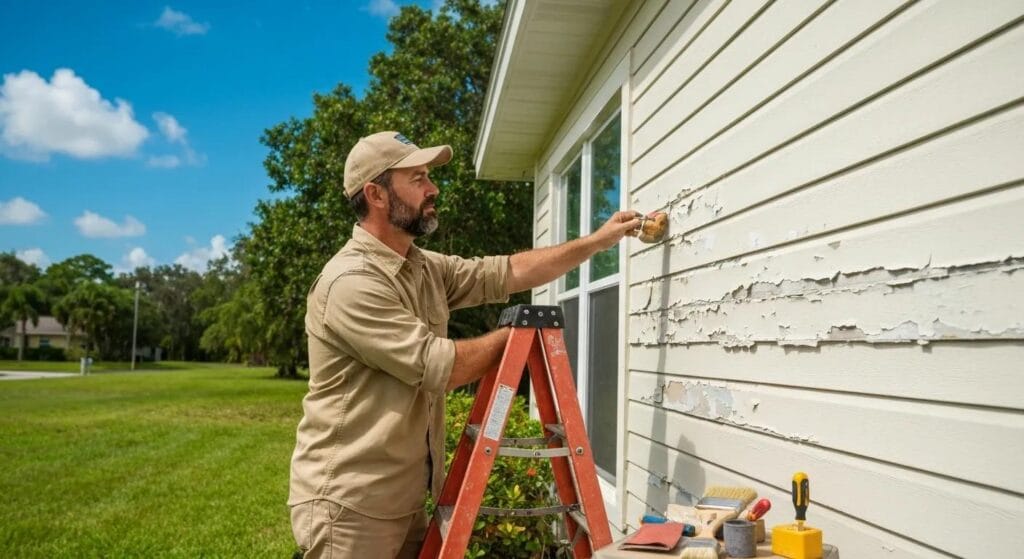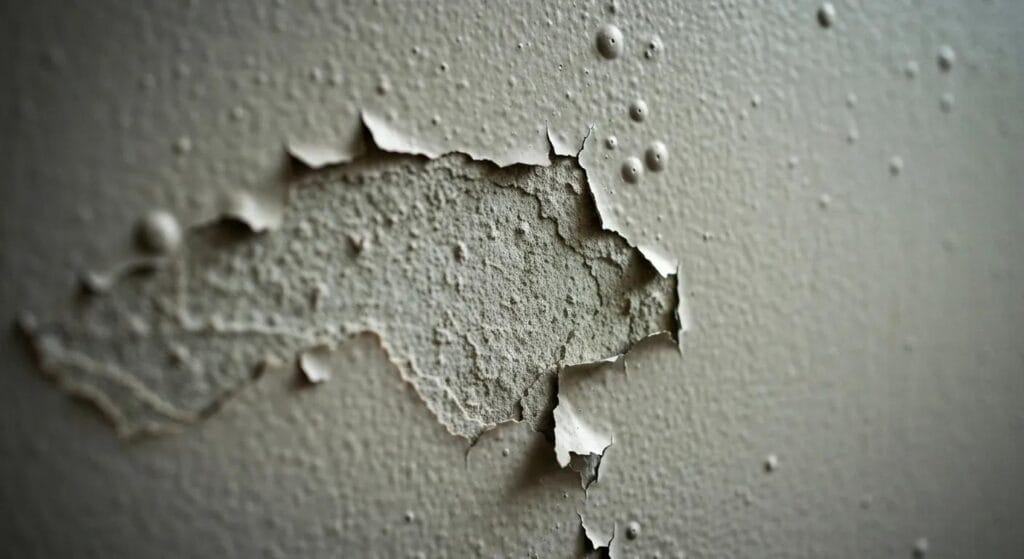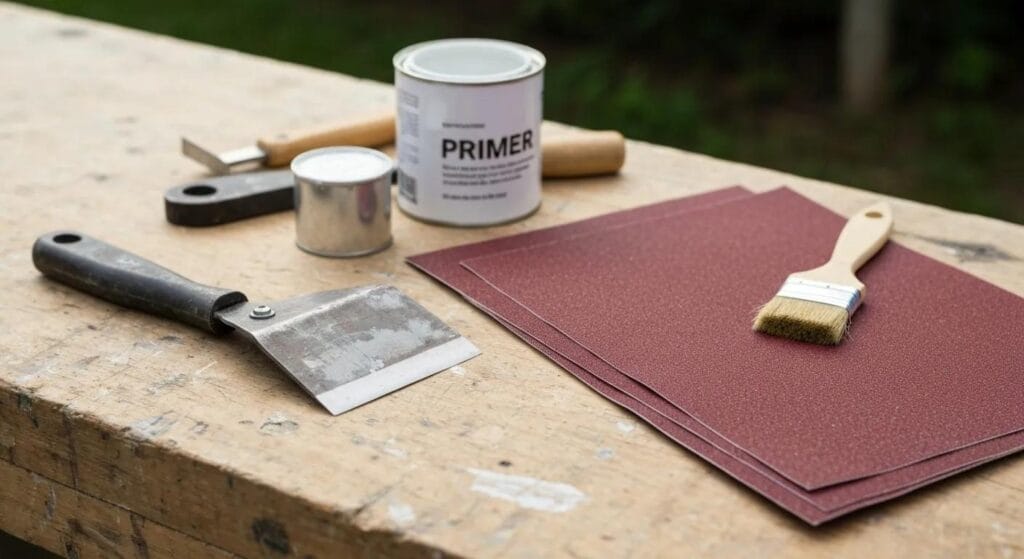
Mastering Peeling Paint Repair: Your Expert Guide for Sarasota & Venice Homes
Unsightly peeling or bubbling paint not only detracts from your home’s curb appeal but often signals deeper issues like moisture intrusion or adhesion failures, especially common in Sarasota and Venice. In this comprehensive guide, you’ll discover how to accurately diagnose the causes, follow a meticulous six-step repair process, select the ideal tools and materials, understand when professional intervention is essential, and implement strategies to prevent future paint problems—all fortified by Grove Street Painting’s unparalleled local expertise and industry-leading warranties. We’ll delve into:
- The core reasons behind paint failure and how to identify them
- Essential repair stages, from initial assessment to the flawless final coat
- Recommended tools, primers, and patching compounds optimized for Florida’s humid climate
- Clear indicators for professional assistance, including vital lead-paint safety protocols
- Proactive prevention strategies specifically designed for Florida’s humidity, salt air, and intense UV exposure
- Exclusive local insights on managing moisture, mildew, and sun damage
Uncover the Hidden Causes of Peeling Paint
Paint peels when the crucial bond between layers weakens, frequently triggered by moisture intrusion, inadequate surface preparation, incompatible paint types, or environmental wear and tear. Recognizing these contributing factors early empowers you to choose the correct remediation steps and avoid frustrating recurring failures.
Common Culprits Behind Peeling Paint
Paint delamination can stem from various issues, including moisture penetration, insufficient surface preparation, and the use of incompatible paint products. Moisture, particularly prevalent in humid climates, severely compromises the adhesive bond between the substrate and the paint coating, leading to peeling. Similarly, poor surface preparation, such as neglecting proper sanding or cleaning, can prevent new paint from adhering correctly.
This research provides valuable insights into the fundamental causes of paint failure, a key focus of this article.
Understanding Peeling Paint: Definitions and Common Types Like Blistering and Flaking
Peeling paint describes the detachment of paint layers from a surface; blistering manifests as bubble-like pockets, while flaking results in thin, detached chips. Both forms compromise the finish’s integrity and leave underlying building materials vulnerable to damage. Accurately identifying whether areas are blistered versus flaked will guide your removal technique and the specific type of filler required.
How Moisture Intrusion Leads to Peeling Paint in Florida Homes

Moisture intrusion lifts paint by critically weakening the bond between the substrate and its coating, a common challenge in high-humidity regions like Sarasota and Venice. Leaks, condensation forming behind walls, and roof runoff introduce water that seeps beneath the paint, creating blisters that eventually burst and peel away. Eliminating these water sources and enhancing drainage are absolutely essential before any repainting efforts begin.
Why Inadequate Surface Preparation Leads to Paint Failure
Insufficient sanding, cleaning, or priming leaves behind grease, dust, or residual coatings that actively block proper adhesion. When painters bypass critical steps—like deglossing shiny surfaces or applying a dedicated bonding primer—new paint struggles to grip, leading to premature peeling. Meticulous preparation ensures each layer chemically and mechanically bonds, effectively preventing early failure.
The Critical Role of Proper Surface Preparation
Thorough surface preparation is paramount for preventing paint failure. This includes meticulously cleaning the surface to eliminate contaminants, sanding to create an optimal profile for adhesion, and priming to effectively seal the surface. Neglecting these vital steps can result in the early delamination of the paint finish.
This citation underscores the article’s emphasis on the profound importance of surface preparation for achieving a truly long-lasting paint finish.
Why Incompatible Paint Types Cause Peeling
Applying latex paint directly over oil-based coatings without an appropriate primer creates a barrier that severely hinders adhesion. The molecular mismatch between acrylic polymers and oil binders causes separation under stress, inevitably resulting in peeling. Utilizing a universal bonding primer or ensuring compatible paint chemistry effectively eliminates this common incompatibility issue.
How Age, UV Exposure, and Environmental Factors Impact Paint Durability
Sunlight relentlessly breaks down paint binders through intense ultraviolet radiation, while temperature fluctuations cause substrates to expand and contract, placing immense stress on the coating. Over time, these relentless cycles create micro-cracks that lead to flaking. Regular maintenance and the application of UV-resistant topcoats significantly extend service life by mitigating the effects of weathering and thermal stress.
The Risks of Lead Paint and When Professional Handling is a Must
Homes constructed before 1978 frequently contain lead-based paints that, when disturbed, chip into hazardous dust. DIY removal without proper HEPA containment and certified protective gear can release dangerous toxins. Professional abatement services, equipped with specialized vacuums and strict disposal protocols, are absolutely essential to safeguard family health and ensure full regulatory compliance.
Your Step-by-Step Guide to Flawless Paint Repair
A systematic, six-step process is key to ensuring lasting adhesion and a truly flawless finish when repairing peeling or bubbling paint in Florida’s demanding climate.
Step 1: Assess Damage and Prioritize Safety Before You Begin
Begin by thoroughly inspecting the extent of the peeling and testing any suspect areas for lead using a reliable DIY kit. Ensure ample ventilation or utilize an air-scrubber, and always wear a respirator specifically rated for particulates. This crucial assessment prevents health risks and accurately informs your material requirements.
Step 2: Master the Art of Removing Loose and Damaged Paint
Employ a sharp paint scraper or putty knife to carefully lift and discard all loose flakes and blisters. Work at a shallow angle to prevent gouging the underlying substrate. Thoroughly clearing unstable paint prevents future undercutting and establishes a solid, stable base for new coatings.
Step 3: Achieve a Smooth Surface for Perfect Paint Adhesion
After scraping, meticulously sand rough edges with medium-grit (80–120) sandpaper to seamlessly feather the transition between intact paint and the bare substrate. Apply joint compound or patching plaster into any dents and gouges. Sand again once completely dry to achieve a perfectly level surface, ready for primer.
Step 4: The Crucial Cleaning Step for Lasting Paint
Cleaning meticulously removes dust, oils, mold, and mildew that would otherwise block primer adhesion. A trisodium phosphate (TSP) solution or a specialized mildewcide effectively clears these contaminants. Rinsing and drying completely restores the surface’s porosity, which is absolutely crucial for bonding new coatings.
Step 5: Choose and Apply the Right Primer for Unbeatable Adhesion
High-bonding or block-resistant primers effectively seal porous patches and create a uniform substrate. In humid Sarasota and Venice, always opt for primers specifically labeled “moisture-tolerant” or “salt-air resistant.” Rollers and brushes should apply a uniform coat, followed by light sanding once cured for optimal paint adhesion.
Step 6: Apply New Paint Coats Like a Pro
Apply two finish coats using a high-quality acrylic-based latex paint formulated for exterior or interior use as appropriate. Maintain wet edges to meticulously avoid lap marks, and strictly adhere to recommended dry times between coats. Precise temperature and humidity control during application ensure proper film formation and exceptional long-term durability.
Essential Tools and Materials for a Professional Paint Repair

Gather these indispensable tools and supplies to streamline your repair workflow and achieve truly professional-quality results.
Before you begin, assemble the following list of tools and materials, specifically chosen for Florida’s climate and common substrates.
| Tool or Material | Purpose | Recommendation |
|---|---|---|
| Paint Scraper & Putty Knife | For removing loose paint and smoothing edges | Opt for a stainless steel blade with an ergonomic handle |
| Medium-Grit Sandpaper | To feather edges and smooth patched areas | Use an 80–120 grit sanding block for best results |
| Bonding Primer | To seal the substrate and significantly enhance adhesion | Choose a moisture-tolerant, block-resistant formula |
| Acrylic Latex Paint | For durable finish coats with UV and mildew resistance | Select exterior/interior grade, specifically for humidity |
| Patching Compound | To effectively fill cracks and gouges | A low-shrink joint compound is ideal |
This table meticulously outlines the core items that, when used in sequence, create a truly durable paint system.
Know When to Call the Pros for Peeling Paint Repair
While DIY repair is suitable for minor peeling, extensive damage, persistent moisture sources, or the presence of lead paint often necessitate professional intervention to guarantee safety and superior quality.
Is Your Peeling Paint Damage Too Extensive for DIY?
Large areas of bubbling, evidence of structural water damage, or widespread flaking indicate deeper, more complex issues like rot or mold that extend far beyond simple surface repair. When more than 20% of a wall exhibits deterioration, engaging experts prevents repeated failures and uncovers hidden structural risks.
Why Professional Lead Paint Remediation is Essential for Your Family's Safety
Certified professionals utilize containment barriers, HEPA-filtered vacuums, and specialized coatings to safely encapsulate or remove lead-based layers. This meticulously controlled process prevents toxic dust exposure and ensures full regulatory compliance, rigorously protecting both occupants and the environment.
The Grove Street Painting Advantage: Warranties and Expertise You Can Trust
Grove Street Painting proudly offers a lifetime warranty on interior and cabinet painting, plus a robust 10-year exterior warranty, combined with complimentary touch-ups for life. This unwavering commitment provides unparalleled peace of mind and unequivocally demonstrates our confidence in our adhesion protocols and premium materials.
Revitalize Your Cabinets with Professional Refinishing
Cabinet surfaces demand precise stripping, sanding, priming, and sealing techniques that differ significantly from wall painting. Professional cabinet refinishing ensures uniform adhesion on wood veneers and solid core doors, restoring bright, chip-resistant finishes that expertly withstand moisture and frequent use.
Prevent Future Paint Problems and Maintain a Flawless Finish
Implementing proper preparation, meticulous material selection, and consistent maintenance routines is your strongest defense against recurring paint failure.
Why Proper Surface Preparation is Your Best Defense Against Paint Failure
Meticulous surface preparation removes contaminants and levels the substrate, allowing primer and paint to bond both chemically and mechanically. Skipping essential prep steps traps oils and dust beneath the paint, leading to early delamination. Consistent cleaning, sanding, and priming build an unshakeable foundation for lasting adhesion.
Choosing the Right Paints for Sarasota and Venice's Climate
Opt for acrylic-based paints fortified with UV-block additives and mildewcide. These advanced formulations are specifically designed to resist Florida’s intense sunlight and high humidity. Exterior paints should proudly carry a “coastal” or “salt-air resistant” label to effectively combat corrosion and chalking on seaside properties.
The Vital Role of Ventilation and Moisture Control in Paint Longevity
Adequate airflow in bathrooms, kitchens, and laundry rooms actively prevents condensation that undermines paint adhesion. Installing efficient exhaust fans, promptly repairing leaks, and diligently maintaining gutters diverts moisture away from walls. Controlled indoor humidity (below 60%) critically preserves paint film integrity.
How Regular Maintenance Keeps Peeling Paint at Bay
Routine inspections for cracks, blistering, or mildew allow for early spot repairs before widespread damage occurs. Diligently cleaning gutters, caulking gaps, and touching up chips keeps water out of vulnerable areas. Proactive upkeep significantly extends coating life and steadfastly protects your home’s value.
Local Factors Affecting Paint Durability in Sarasota and Venice, FL
Florida’s unique coastal environment presents significant challenges to paint durability with its high humidity, pervasive salt air, intense UV radiation, and prevalent mildew. Understanding these specific factors clarifies the absolute necessity for specialized products and practices.
How High Humidity and Salt Air Impact Exterior Paint
Salt-laden breezes accelerate chalking and corrosion on metal trims, while humidity draws moisture into porous surfaces, actively promoting blistering. Salt crystals trapped under paint films disrupt adhesion, making corrosion-inhibiting primers absolutely essential for coastal exteriors.
Essential UV Protection Measures for Your Home's Exterior
Direct sunlight relentlessly degrades binder polymers, causing chalking and significant color fading. Utilizing UV-absorbing additives in topcoats preserves pigments and maintains film flexibility. Regular application of a clear UV barrier on trim and railings further shields vulnerable areas from sun damage.
How Mildew Affects Paint and How to Prevent It
Mildew colonies feed on organic binders, leaving unsightly black or green spots and critically weakening the paint film. Incorporating mildewcide-infused primers and paints, combined with routine soft-wash cleaning, effectively inhibits fungal growth and preserves aesthetic integrity.
Your Top Questions About Peeling Paint, Answered
Homeowners frequently inquire about how to address peeling walls, what triggers paint detachment, and whether painting over damaged areas is advisable—all critical considerations before embarking on any repair project.
How to Fix Peeling Paint on Walls for a Lasting Finish
Begin by meticulously scraping loose paint, carefully sanding edges, thoroughly cleaning with a TSP solution, priming with a high-bond primer, and finally applying two finish coats. This precise sequence restores adhesion and delivers a smooth, durable surface.
What Causes Paint to Peel Off Walls?
Paint peels primarily due to trapped moisture, inadequate substrate preparation, incompatible layers, or UV-driven binder breakdown. Eliminating water sources and diligently following proper preparation steps resolves most underlying causes.
Can You Paint Over Peeling Paint?
Painting directly over peeling areas will inevitably lead to rapid re-failure. Always remove all loose coatings, meticulously sand and fill imperfections, then prime thoroughly before applying topcoats to ensure lasting adhesion.
What Is the Best Primer for Peeling Paint?
A moisture-tolerant, bonding primer specifically designed for coastal climates provides superior adhesion to both bare substrate and old paint. Look for “block-resistant” or “universal bond” labeling to support multiple surfaces effectively.
How Long Does Peeling Paint Repair Take?
Small patches can be completed in under a day, including necessary dry times. Larger areas or lead-safe work may require two to three days for full preparation, priming, and topcoating under ideal conditions.
Ready for a Flawless Finish? Connect with Grove Street Painting for Expert Peeling Paint Repair
Partner with Sarasota’s highest-rated local painting contractor to guarantee a long-lasting, truly flawless finish without any worry.
Peeling paint signals deeper issues that, when addressed methodically, can truly restore and protect your home’s surfaces. By accurately diagnosing the cause, diligently following best-practice repair steps, utilizing climate-appropriate materials, and leveraging Grove Street Painting’s robust warranties and unparalleled expertise, homeowners in Sarasota and Venice can confidently enjoy flawless, durable finishes for many years to come.
